#Vimy Ridge Cross
Photo
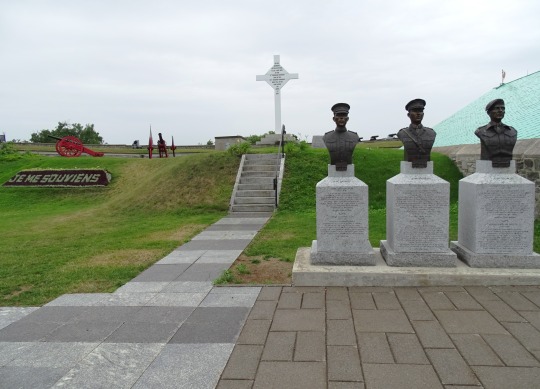


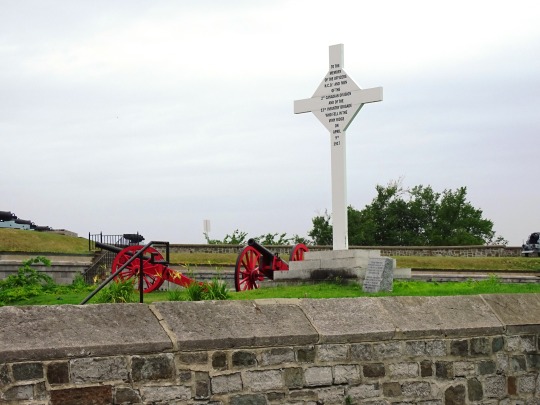
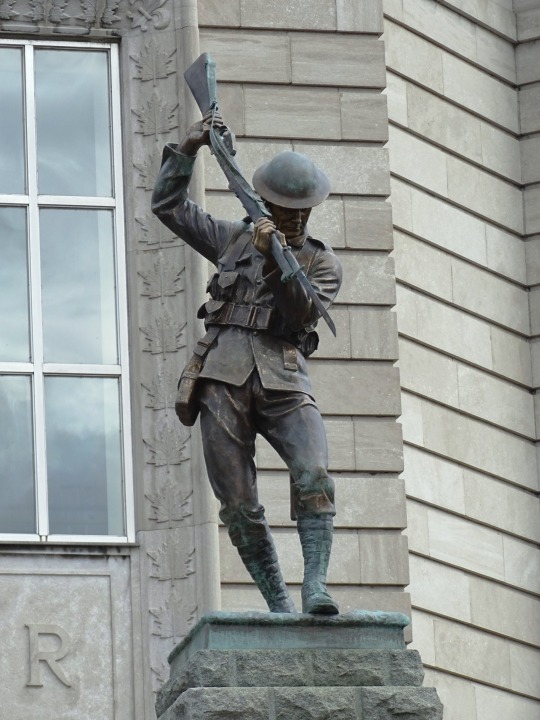

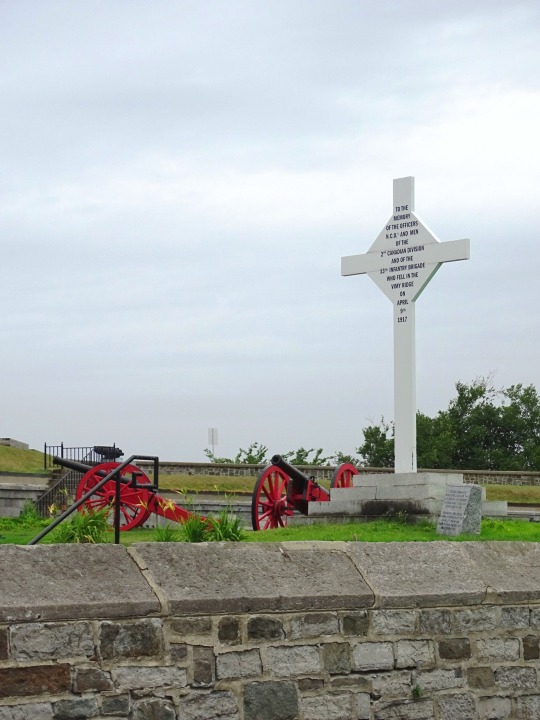


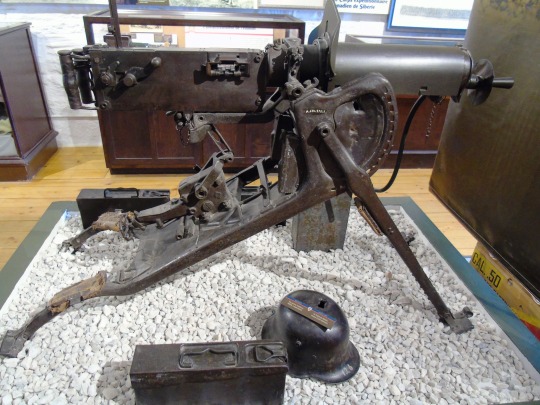
World War I: Canadian forces successfully completed the taking of Vimy Ridge from the Germans on April 12, 1917.
#National War Memorial_The Response by Vernon March#Vimy Ridge Cross#The Road to Vimy and Beyond#Royal 22e Régiment Museum#Citadelle of Quebec#Quebec City#Québec#Ottawa#Ontario#Canada#summer 2018#2015#original photography#Trois-Rivières#citysccape#travel#Monument to the Brave by Cœur-de-Lion McCarthy#Army Museum Halifax Citadel#taking of Vimy Ridge#12 April 1917#anniversary#Canadian history#WWI#World War I#World War One#Fort George#Halifax Citadel National Historic Site of Canada
4 notes
·
View notes
Photo







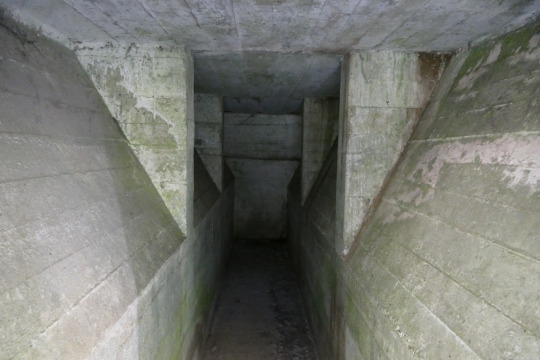
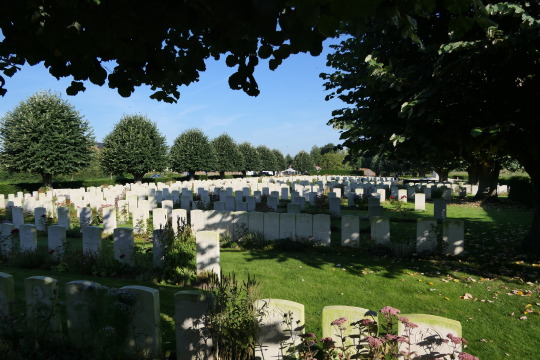

Essex Farm Cemetery
John McCrae Canadese arts
In Flanders Fields
In Flanders fields the poppies blow
Between the crosses, row on row,
That mark our place; and in the sky
The larks, still bravely singing, fly
Scarce heard amid the guns below.
We are the Dead. Short days ago
We lived, felt dawn, saw sunset glow,
Loved, and were loved, and now we lie
In Flanders fields.
Take up our quarrel with the foe:
To you from failing hands we throw
The torch; be yours to hold it high.
If ye break faith with us who die
We shall not sleep, though poppies grow
In Flanders fields.
John McCrae
Een van de meest aangrijpende herinneringen aan de Eerste Wereldoorlog is het ontroerende gedicht 'In Flanders Fields', geschreven door John McCrae, een Canadese legerdokter, na de dood van zijn goede vriend en landgenoot luitenant Alexis Helmer. Helmer kwam op 2 mei 1915 om het leven toen een granaat ontplofte tijdens de tweede Duitse gasaanval. Bij afwezigheid van een kapelaan leidde McCrae zelf de uitvaartdienst voor zijn vriend. Verdriet en het trauma van de oorlog inspireerden zijn gedicht.
Op dat moment was majoor John McCrae aan het werk in een velddressingstation op de weg tussen Ieper en Boezinge. Daar hield hij zich vooral bezig met de behandeling van slachtoffers van de Duitse gasaanvallen. Kort nadat hij het gedicht had geschreven, werd hij als Chief of Medical Services overgebracht naar een Canadees veldhospitaal in Frankrijk, waar de gewonden van de veldslagen van de Somme, Vimy Ridge, Arras en Passendale werden behandeld.
McCrae legde het vel papier weg waarop hij het gedicht had geschreven. Het zou misschien nooit zijn gepubliceerd als een collega-officier de aantekeningen van McCrae niet had gevonden en ze naar een aantal Londense tijdschriften had gestuurd. Het gedicht verscheen voor het eerst in het tijdschrift Punch en raakte meteen de harten van het Britse volk.
In de zomer van 1917 kreeg John McCrae aanvallen van astma en bronchitis, vrijwel zeker als gevolg van het inademen van chloorgas tijdens de Tweede Slag om Ieper. Op 23 januari 1918 werd McCrae ziek met een longontsteking en werd hij opgenomen in het ziekenhuis. Hij stierf vijf dagen later op slechts 46 jarige leeftijd. McCrae is begraven in Wimereux, ten noorden van Boulogne (Frankrijk).
John McCrae
One of the most poignant reminders of World War I is the moving poem, ‘In Flanders Fields’, written by John McCrae, a Canadian army doctor, following the death of his close friend and compatriot Lieutenant Alexis Helmer. Helmer was killed on 2 May 1915 when a shell exploded during the second German gas attack. In the absence of a chaplain, McCrae conducted the funeral service for his friend himself. Grief and the trauma of war inspired his poem.
At the time, Major John McCrae was working in a field dressing station on the road between Ypres and Boezinge. While there, he was mainly involved in treating victims of the German gas attacks. Soon after he wrote the poem, he was transferred, as Chief of Medical Services, to a Canadian field hospital in France, where the wounded from the battles of the Somme, Vimy Ridge, Arras, and Passchendaele were treated.
McCrae discarded the sheet of paper on which he had written the poem. It might never have been published but for a fellow officer who found McCrae’s notes and sent them to a number of London magazines. The poem first appeared in the magazine Punch and immediately touched the hearts of the British people.
In the summer of 1917, John McCrae suffered attacks of asthma and bronchitis, almost certainly as a consequence of inhaling chlorine gas during the Second Battle of Ypres. On 23 January 1918, McCrae fell ill with pneumonia and was admitted to hospital. He died five days later at only 46 years of age. McCrae is buried in Wimereux, north of Boulogne (France).
Het verhaal van Joe Strudwick, de jongst gesneuvelde militair.
Joe werd geboren op woensdag 14 februari – vandaar zijn voornaam Valentine – 1900 in Falkland road, Dorking, Surrey. Hij was de tweede zoon van Jesse Strudwick, een tuinier en Louisa Fuller, wasvrouw van beroep. In totaal had hij twee stiefzussen (uit het eerste huwelijk van zijn vader), drie broers en twee zussen. Na zijn beperkte opleiding op de school van St. Paul’s in zijn buurt, ging hij werken als landbouwersknecht en bij een oom die kolenhandelaar was. Hij werd beschreven als ‘groot en goed gebouwd’.
Hij meldde zich als vrijwilliger aan in Lambeth, januari 1915 toen hij dus nog maar 14 was! Het is niet duidelijk hoe hij erin slaagde om zijn echte leeftijd te verdoezelen. Na zijn opleiding vertrok hij met het 8ste bataljon van de Riflebrigade (ook genoemd the Prince Consort´s Own) naar Frankrijk op woensdag 19 mei 1915. Op het einde van die maand kreeg hij al praktijkopleiding met het regiment van de ‘North en South Staffordshires’ in de frontlinies van de Ploegsteertsector. (Zijn bataljon is toegevoegd aan de 1/5th en 1/6th North and South Staffordshire, 46 North Midland Division – 137th Brigade). Zijn eerste opdracht voerde hij uit op 7 juni bij St. Elooi. Maar kort daarna werd hij al gewond en naar Engeland teruggestuurd om te herstellen in Sheerness, Kent. Hij heeft door zijn verblijf in Engeland waarna hij pas op 12 augustus terugkeert, de verschrikkelijke gevechten rond Bellewaarde en het Hooge niet moeten meemaken (16/6/1915 Bellewaarde Ridge, 19/7/1915 Hooge Crater mijn, 30-31/7/1915 eerste aanval met vlammenwerper en 9/8/1915 mijnkrater terug heroverd).
Op woensdag 12 augustus keerde hij terug naar de ‘Ypres salient’ waar hij zich opnieuw voegde bij wat er nog overbleef van het 8ste bataljon. Het bataljon had immers zware verliezen geleden – 19 officieren en 469 manschappen –- op 30 juli bij Hooge. Via zijn makkers in zijn peloton kwam hij gauw genoeg te weten wat het droevige lot was geweest van vele vrienden bij de aanval op Hooge. Zijn eerste taak was nu om karweien uit te voeren bij het kanaal van Ieper naar Boezinge. Daarna keerde hij terug naar de frontlinies bij Potyze op 23 augustus. Begin september was hij tijdens zijn dienst getuige van een hevig luchtgevecht boven de Britse frontlijn, waarbij het Britse vliegtuig werd neergehaald en te pletter stortte in Duits gebied. Op 6 september werd hij afgelost en naar ‘Ginger Bread Chateau’ (kasteel van de Potyze?) gebracht, waar hij door een omnibus werd opgepakt en naar Watou gevoerd om daar te rusten, te oefenen en karweien uit te voeren.
Dat stemde hem tevreden omdat hij eindelijk een warm bad kon nemen en vers ondergoed aantrekken! In Poperinge kon hij ook voor even genieten van andere verstrooiing samen met vrienden. Op 6 september wordt zijn brigade afgelost en naar “Ginger Bread Chateau” en verder naar Watou. In de War Diary van 9/9/1915 (zie afbeelding onder) staat dat er een “zorgvuldige” medische inspectie was en 35 niet fit genoeg waren voor verdere dienst, er 15 leden aan ‘nervous breakdown” en er 10 anderen waren jonger dan 18 jaar. Bijgevolg, Strudwick was niet de enige in dit bataljon die door de mazen van het net was geglipt.
Op 13 september marcheerde hij naar Poperinge van waaruit hij per trein naar ‘Ypres Asylum’ (station van Ieper) werd gebracht en van daar naar hun kampement waar ze in reserve afwachtten. De volgende morgen kreeg hij karweien die de eerste twee weken zouden in beslag nemen. Daarna werd hij op 28 september naar de loopgraven gestuurd bij ‘Bellewaerde farm’ (Hooge). In deze periode werd Ieper en de omgeving van het Hooge en Bellewaarde Farm hevig gebombardeerd. De afgrijselijke taferelen die hem daar opwachtten, werden nog versterkt door een weerzinwekkende geur van ontbindende lijken. De loopgraven waren in een verschrikkelijke toestand, volledig ondergelopen en fel beschadigd na de voorgaande gevechten.
In de War diary van 23/9/1915 lezen we: Bn bivouacked. Refitting and reorganising … Received to send back to Engeland men under 17 years of age. Waarschijnlijk het gevolg van het medisch onderzoek hierboven vermeld. Hier weer de vraag: Waarom bleef Strudwick?
War diary 6/10/1915: bataljon wordt afgelost en “A general feeling throughout the Bn that the 14th Div. has had more than its share of this unpleasant salient. Men have lost confidence and do not show themselves at their best”. (“Een algemeen gevoel overal in het bataljon dat de 14de div. meer dan zijn aandeel van deze onaangename salient heeft gehad. De mannen hebben hun vertrouwen verloren en vertonen zich niet op hun best”.)
En dan verder op 11/10/1915: een steeds groter probleem is hoe er moet omgegaan worden met mannen in de loopgraven waarvan de zenuwen het dreigen te begeven. Hierbij rijst de vraag hoe Strudwick hiermee omging?
Tijdens de maand november en december verblijven ze alternerend in rustkampen of staan ter beschikking van o.a. de 6th Division voor werken aan de frontlinie in de omgeving van het Ieper-IJzer kanaal. Ondertussen blijven de artillerie van de machinegeweren aan beide zijden zeer actief. Niet alleen de frontlinies krijgen hun deel artillerievuur te verwerken maar ook het achterland. Er zijn geen belangrijke acties of aanvallen en het is een zogezegde rustige periode maar als we de slachtoffers bekijken voor de periode van 1 november tot 17 december: 2 officieren gedood en 10 gewond. Bij de manschappen vielen er 81 doden en 228 gewonden. Eind december gaat de 14th Div. op rust in Frankrijk om dan begin januari 1916 terug te keren naar de omgeving van het kanaal.
Voor de periode van december tot januari 1916 zijn blijkbaar de War Diary voor het 8th Bn niet voorhanden of verloren/vernietigd. Uit het divisiedagboek kunnen we opmaken dat de divisie het gebied van La Belle Alliance, Frascati, Hill Top Farm, Noordhof farm en Belmont Farm bezetten. (Zie boven: uittreksel uit loopgravenkaart St Julien 28 N W 2 met deze gebieden omcirkeld).
Uit het dagboek blijkt verder dat ze dagelijks onder Duits artillerievuur lagen. Verder zijn het rustige dagen. Als je het aantal slachtoffers bekijkt (uit de lijst met slachtoffers als bijlage bij het dagboek) blijkt dat er in de 41st Infantry Brigade, waartoe 8th Bn Rifle Brigade behoort, er tussen 1 januari en 14 januari 1916, 286 slachtoffers vallen (6 officieren en 280 manschappen) Op 14 januari 1916 is dat één officier en 16 manschappen. Strudwick is één van de doden.
The Dorking Advertiser publiceerde na zijn dood het volgende op zaterdag 22 januari 1916: (vrij vertaald)
Nog een soldaat uit Dorking is eervol gesneuveld voor zijn vaderland.
Soldaat Valentine Joe Strudwick van het 8ste Rifle Brigade trad in dienst 12 maanden geleden, en op de dag van zijn overlijden op 14 januari had hij de leeftijd van 16 jaar nog niet bereikt, daar hij geboren was op Valentijnsdag 1900. Zijn moeder zou hem natuurlijk nog een paar jaar liever niet in het leger gezien hebben, maar de jonge Strudwick had daar geen oren naar – een mooi voorbeeld voor ouderen die zich nog niet aangemeld hebben en misschien een verwijt!
Na slechts zes weken opleiding werd hij naar Frankrijk gestuurd. Al gauw verloor hij twee kameraden die naast hem stonden – allebei op slag dood. Hij was daardoor zo geschokt en bovendien ook het slachtoffer van een gasaanval, dat hij voor drie maanden opgenomen werd in het ziekenhuis van Sheerness. Na herstel vervoegde hij zijn regiment en deze week dan kreeg zijn moeder het volgende bericht van zijn commandant, gedateerd op 15 januari:
Het spijt me ten zeerste u te moeten informeren dat uw zoon gedood werd door een granaatinslag op 14 januari. Hij was op slag dood en heeft niet geleden. Zijn lichaam werd door een aantal kameraden gebracht naar een kleine begraafplaats achter de linies waar het deze morgen eervol begraven werd. Een kruis wordt gemaakt en zal spoedig op zijn graf geplaatst worden. Rifleman Strudwick werd gerespecteerd door zijn kameraden en officieren en het spijt ons ontzettend om zulk een goede soldaat te moeten verliezen. Van hun kant én de onze bied ik u onze oprechte blijken van medeleven aan.
De overledene was mevrouw Strudwick’s tweede overlevende zoon en haar verdriet is des te groter daar zij hem niet meer had kunnen zien sedert hij in dienst trad. Ze heeft een tweede zoon in de Royal Field Artillery.
De jonge Strudwick was een oud-leerling van St Paul’s.
De oudere broer, Jesse Strudwick, regimentsnummer 121109 werd uit het leger ontslagen op 3 juli 1916 om medische reden (ziekte). Joe ontving de Victory Medal, de British War Medal en de 1915 Star Medal. Hij ligt begraven op Essex Farm Cemetery In Plot I Rij U. Op zijn grafsteen staat als epitaaf: “Niet uit onze herinneringen, noch verstoken van onze liefde.” (“Not gone from memory or from love”). Hij wordt ook herdacht op het Dorking oorlogsmonument en de namenlijst (Roll of Honour) van St. Paul’s en St. Martin’s Parish Churches.
9 notes
·
View notes
Text
Events 4.12
240 – Shapur I becomes co-emperor of the Sasanian Empire with his father Ardashir I.
467 – Anthemius is elevated to Emperor of the Western Roman Empire.
627 – King Edwin of Northumbria is converted to Christianity by Paulinus, bishop of York.
1012 – Duke Oldřich of Bohemia deposes and blinds his brother Jaromír, who flees to Poland.
1204 – The Crusaders of the Fourth Crusade breach the walls of Constantinople and enter the city, which they completely occupy the following day.
1606 – The Union Flag is adopted as the flag of English and Scottish ships.
1776 – American Revolution: With the Halifax Resolves, the North Carolina Provincial Congress authorizes its Congressional delegation to vote for independence from Britain.
1807 – The Froberg mutiny on Malta ends when the remaining mutineers blow up the magazine of Fort Ricasoli.
1820 – Alexander Ypsilantis is declared leader of Filiki Eteria, a secret organization to overthrow Ottoman rule over Greece.
1831 – Soldiers marching on the Broughton Suspension Bridge in Manchester, England, cause it to collapse.
1861 – American Civil War: Battle of Fort Sumter. The war begins with Confederate forces firing on Fort Sumter, in the harbor of Charleston, South Carolina.
1862 – American Civil War: The Andrews Raid (the Great Locomotive Chase) occurs, starting from Big Shanty, Georgia (now Kennesaw).
1864 – American Civil War: The Battle of Fort Pillow: Confederate forces kill most of the African American soldiers that surrendered at Fort Pillow, Tennessee.
1865 – American Civil War: Mobile, Alabama, falls to the Union Army.
1877 – The United Kingdom annexes the Transvaal.
1900 – One day after its enactment by the Congress, President William McKinley signs the Foraker Act into law, giving Puerto Rico limited self-rule.
1910 – SMS Zrínyi, one of the last pre-dreadnought battleships built by the Austro-Hungarian Navy, is launched.
1917 – World War I: Canadian forces successfully complete the taking of Vimy Ridge from the Germans.
1927 – Shanghai massacre of 1927: Chiang Kai-shek orders the Chinese Communist Party members executed in Shanghai, ending the First United Front.
1927 – Rocksprings, Texas is hit by an F5 tornado that destroys 235 of the 247 buildings in the town, kills 72 townspeople and injures 205; third deadliest tornado in Texas history.
1928 – The Bremen, a German Junkers W 33 type aircraft, takes off for the first successful transatlantic aeroplane flight from east to west.
1934 – The strongest surface wind gust in the world at the time of 231 mph, is measured on the summit of Mount Washington, New Hampshire. It has since been surpassed.
1934 – The U.S. Auto-Lite strike begins, culminating in a five-day melee between Ohio National Guard troops and 6,000 strikers and picketers.
1937 – Sir Frank Whittle ground-tests the first jet engine designed to power an aircraft, at Rugby, England.
1945 – U.S. President Franklin D. Roosevelt dies in office; Vice President Harry S. Truman becomes President upon Roosevelt's death.
1945 – World War II: The U.S. Ninth Army under General William H. Simpson crosses the Elbe River astride Magdeburg, and reaches Tangermünde—only 50 miles from Berlin.
1955 – The polio vaccine, developed by Dr. Jonas Salk, is declared safe and effective.
1961 – Space Race: The Soviet cosmonaut Yuri Gagarin becomes the first human to travel into outer space and perform the first crewed orbital flight, Vostok 1.
1963 – The Soviet nuclear-powered submarine K-33 collides with the Finnish merchant vessel M/S Finnclipper in the Danish straits.
1970 – Soviet submarine K-8, carrying four nuclear torpedoes, sinks in the Bay of Biscay four days after a fire on board.
1980 – The Americo-Liberian government of Liberia is violently deposed.
1980 – Transbrasil Flight 303, a Boeing 727, crashes on approach to Hercílio Luz International Airport, in Florianópolis, Brazil. Fifty-five out of the 58 people on board are killed.
1980 – Canadian runner and athlete, Terry Fox begins his Marathon of Hope Run in St. John's, NF.
1981 – The first launch of a Space Shuttle (Columbia) takes place: The STS-1 mission.
1983 – Harold Washington is elected as the first black mayor of Chicago.
1990 – Jim Gary's "Twentieth Century Dinosaurs" exhibition opens at the Smithsonian Institution National Museum of Natural History in Washington, D.C. He is the only sculptor ever invited to present a solo exhibition there.
1992 – The Euro Disney Resort officially opens with its theme park Euro Disneyland; the resort and its park's name are subsequently changed to Disneyland Paris.
1999 – United States President Bill Clinton is cited for contempt of court for giving "intentionally false statements" in a civil lawsuit; he is later fined and disbarred.
2002 – A suicide bomber blows herself up at the entrance to Jerusalem's Mahane Yehuda Market, killing seven people and wounding 104.
2007 – A suicide bomber penetrates the Green Zone and detonates in a cafeteria within a parliament building, killing Iraqi MP Mohammed Awad and wounding more than twenty other people.
2009 – Zimbabwe officially abandons the Zimbabwean dollar as its official currency.
2010 – Merano derailment: A rail accident in South Tyrol kills nine people and injures a further 28.
2013 – Two suicide bombers kill three Chadian soldiers and injure dozens of civilians at a market in Kidal, Mali.
2014 – The Great Fire of Valparaíso ravages the Chilean city of Valparaíso, killing 16 people, displacing nearly 10,000, and destroying over 2,000 homes.
1 note
·
View note
Text

Nurses wearing the Red Cross stand alongside French ambulance staff in September 1916 during the Battle of Verdun.
#ww1#world war 1#history#world war one#first world war#great war#canada#war history#canadian history#vimy ridge#verdun#1917#nurses#france#red cross
10 notes
·
View notes
Text
Female Mark II Tank s/n 598
Female Mark II Tank s/n 598. Mark II Tanks were supposed to be trainers but demand forced them to the front lines.

A Tank crossing the German front line at Vimy. November, 1917
Item no. (creator):O-2285
Item ID number:3522071

AWM A02855
The taking of Vimy Ridge. Members of the Canadian Army advancing with a Mark II Female tank over no mans land towards the German lines.

AWM H06931
France, c. 1917. Canadian Army troops advancing in an attack behind a Mk II tank Female, no 599, 'C39' of C Battalion, 8 Company. This tank was commanded by Lt J Cameron, and was knocked out on 11 April 1917. The body of a dead soldier lies in the foreground. (Canadian Official Photograph)
Tank
28 Mar 1917 – "D" Battalion - Train 4 A.C.Q for Canadian Corps (W21)
9 Apr 1917 – "D" Battalion, 12 Company, D43 – Attached to Can Corps, possibly photographed in assembly area (IWM CO1568)
Ditched, recovered (W21) Photographed in action (AWM H06931, AWM A02855) and whilst ditched (X42.p30)
12 Apr 1917 – Back at railhead (W21)
3rd May – "D" Battalion, 12 Company, D43, Lt AR Lawrie - Attached to 62 Division, Destroyed by shellfire. (W21)
25 notes
·
View notes
Photo

Roy Victor Jones
In Park Lawn Cemetery in Etobicoke is a misshapen bronze stump where a cross once stood. It looks like a gnarled finger flayed at the tip. Though no longer whole, it still points to the heavens, at the soldier it was meant to memorialize.
His name was Lieut. Roy Victor Jones of the 75th battalion, and he was killed instantly by a German machine-gunner while leading his platoon at the Battle of Vimy Ridge in 1917. Jones, the middle child in a wealthy Toronto family, left the city to fight in the Great War at 19 years old. Three years later he was dead.
Fifty years after that, a priceless relic and symbol of Jones’s sacrifice was looted from his memorial. Where it is today is a mystery, one that has tormented Jones’s family for half a century.
When Jones was buried in France, he and others who died had their graves marked by wooden crosses with diamond-shaped borders. Postwar, many of those fragile crosses were burned and replaced by stone markers.
But not Jones’s.
“When you go to Flanders Fields, you expect to see crosses,” said historical blogger Martha Jackson. “John McCrae wrote ‘Between the crosses, row on row.’ But they’re not there. They were offered to parents and widows if they wanted to have them shipped home. Most didn’t, but Jones’s family did. It would have been a real treasure.
- Toronto Star
14 notes
·
View notes
Photo
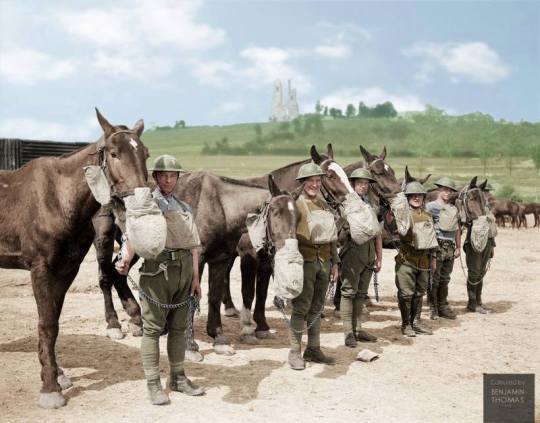
15 May 1918
Gunners of the Royal Field Artillery training their horses in gas mask drill near Mont-Saint-Éloi, Nord-Pas-de-Calais.
The ruins of the abbey can be seen in the background.
(Photographer - Second Lieutenant David McLellan)
(© IWM Q 8794)
On the hill overlooking Arras stand the remains of the two towers which bear testament not only to the once-powerful Mont-Saint-Eloi Abbey but also to the savage fighting that took place in the area during the Great War.
From the beginning of the War the abbey towers were used by French troops to observe German positions on Lorette Spur and Vimy Ridge. The suspicions of the French soldiers were aroused when Germans fired upon their every movement until it was realised that what was giving them away was not a spy but the birds nesting on the towers which took flight when troops disturbed them.
In early 1916 the British Army relieved French troops in the sector. The latter had established an extension to the local cemetery in Ecoivres, at the foot of the hill, to bury 786 of their soldiers who died there, mostly in the fighting of 1915. A military tramway used to carry supplies to the troops at the front also served as an ambulance to bring back the dead and wounded. This transport system conferred on Ecoivres Military Cemetery an unusual feature in that, from the French extension to the Cross of Sacrifice, the graves of the mostly British and Canadian soldiers are in chronological order relating to the date of death: the graves of the men of the 46th North Midland Division who relieved the French in March 1916 are followed by those of the 25th Division who fell in the German attack at the foot of Vimy Ridge in May 1916; next come the men of the 47th London Division who died between July and October 1916 and finally the graves of the Canadians who lost their lives in the successful assault on Vimy Ridge in April 1917.
(Colourised by Benjamin Thomas)
https://www.facebook.com/coloursofyesterday
WW1 Colourised Photos
14 notes
·
View notes
Text
don’t take the girl || travis konecny
masterlist

Author’s Note: This exists because @matbaerzal gave me the advice to try writing in the style of (number)+1 if I wanted to make my fics longer. This fic is styled in the format of 2+1 (2 times the girl didn’t go + 1 time she did) because it is based on a song. I chose Travis based solely on the fact that the first scenario of the song references fishing and we know this boy LOVES his fishing. GIF credit to martieblogsstuff!!
Warnings: Maybe a temper tantrum in the first scenario??? I don’t really think the first sceanrio is bad. The second scenario is about an armed robbery, so, uh. Watch out for that if you need to. The third scenario talks about labour/childbirth. The labour itself is a kinda descriptive but the childbirth is by no means graphic. There’s also implied death in the final scenario. This is an angsty mess and I’m sorry in advance to anyone that reads it—
Word Count: 2.0k+
Based On: Don’t Take the Girl by Tim McGraw
Additional: Feminine reader. Since this is based on the song, I just copied the genders of everyone in the song to the fic. I would also like to thank matbaerzal for reading over the fic for me. She’s the real MVP for volunteering to subject herself to this angsty train wreck to make sure it was alright to post. Bless your heart, Amalie.
ONE
Travis' dad was getting the truck packed with the fishing equipment. The two had planned a trip to the river to go fishing for the day. It was Travis’ eighth birthday and they wanted to celebrate. As they were just about to leave, you walked up to the truck, holding one of your grandpa’s fishing rods. Your pigtails swayed in the late winter breeze.
“We can’t leave her here, Travis,” Mr. Konecny said, motioning to you and then glancing at Travis with a smile. “I know you probably don’t want her to go, but someday you’ll change your mind.”
Travis looked from you to his dad and frowned. He crossed his arms over his chest and stomped his foot in the dirt of the driveway.
“Why can’t we take Jimmy or Tommy from school?” He asked, stomping his foot again. “We could even take my best friend, Bo!” He raised his voice which startled you enough to make you hide behind Mr. Konecny.
Mr. Konecny shielded you with his arm as he glanced at you and then to Travis. He gave Travis a stern look but said nothing.
“Take anybody else; just don’t take her!” Travis stomped both of his feet and thrust his arms toward the ground.
You flinched, dropping the fishing rod at Mr. Konecny’s feet. Mr. Konecny bent down and handed the fishing rod back to you. When he stood back up, he looked sternly at Travis.
“If she doesn’t go neither do we,” he said, stepping back to show Travis how frightened you were. Even though Mr. Konecny had stepped back, you still clung to the side of his leg. “Travis, see? You scared her. Apologize.”
Travis looked at you, then to his dad. “Sorry,” he mumbled. “She’s still not coming fishing with us.”
Mr. Konecny looked at Travis, pinched the bridge of his nose and sighed. “Go to your room.” He pointed toward the house. “I’m going to unload the truck since we aren’t going fishing anymore.”
Without a word of protest, Travis stomped off toward the house. The loud slamming of the front door echoed through the backroads air a moment later, causing you to jump slightly. Mr. Konecny bent down and placed a hand on your shoulder.
“Sorry about that, (Y/N),” he said, squeezing your shoulder. “He’s been kind of a brat lately. Hopefully you two can make up someday.”
You smiled, revealing a gap in your teeth. “Thank you, Mr. Konecny.” You reached into the pocket of your coat and handed Mr. Konecny the envelope that you had been keeping there. “Can you give this to Travis? It’s a card I made him for his birthday.”
Mr. Konecny ruffled your hair as he grabbed the envelope with the other hand. “Of course. I’ll give it to him as soon as he’s calmed down.”
Your smile grew wider as you skipped back to your house, pigtails swaying in the wind. You hoped Travis liked what was on the card. You had poured your seven-year-old heart into making it for him.
TWO
It was the summer after Travis’ eighteenth birthday. You two had been dating since sophomore year of high school. The card you had given him all those years ago starting the friendship that even made that possible.
Today, you were on a date to a drive-in movie. It was one the both of you had been excited to see. It was one of the movies in the Marvel Cinematic Universe, this one focusing on Ant-Man.
Travis was holding you as close as he could in the confines of his truck, kissing you every so often. The two of you were so lost in your own little world that you almost missed it when the back passenger door opened and closed. You both turned your heads and saw a masked man holding a gun. He grabbed you by the arm, jerked you backward, and pointed the gun at you.
“If you listen to everything I tell you,” he said, waggling the gun for dramatic effect, “I won’t hurt her.”
“Travis, please listen to him,” you pleaded, looking between Travis and the masked man.
Reaching into his pocket, Travis produced his wallet. “Take some money,” he said, opening the wallet. Travis shook his head before quickly closing it. “Fuck, you might as well take the whole wallet and my credit cards.” He placed the wallet on the centre console.
The masked man snatched it and placed it on his lap. He used his free hand to lead through the contents before he placed the wallet in the pocket of his pants. He glanced between you and Travis, tightening his grip on your arm. He pressed the gun to your temple, causing you to swallow thickly.
“I’m sure your girlfriend here is worth more to you than nine Vimy Ridge Memorials and two passenger trains,” the masked man said, chuckling.
“The watch, Travis.” You motioned weakly with your free arm. “Give him your watch.”
Unlatching the clasp on his watch, Travis slid it off his wrist and handed it to the masked man. “My grandpa gave this to me but you can have it.” The masked man pocketed the watch and motioned to the keys in the ignition.
“What about those?” His voice was softer than it had been before, almost as if he was suddenly regretting doing this.
Travis quickly took the keys from the ignition and handed them to the masked man. “All yours. The truck is all yours. Just don’t take her.”
You heard the pleading tone to Travis’ voice as he spoke. It made the situation that much more intense. You wanted to do something, anything to help. The fact that you were the reason this was happening made you feel helpless.
The masked man released your arm. You quickly rubbed it to soothe the ache his grip had caused. The masked man motioned to the doors on either side of the truck, huffing loudly.
“Out before I change my mind.”
Scrambling out of the truck, you and Travis made sure to look as innocuous as possible. The last thing you needed was to draw any attention to yourselves and somehow make this situation worse.
As soon as you both stepped away from the truck, it revved to life. Travis’ heart sank as he watched his beloved truck drive away without either you or him in the driver’s seat. You leaned onto him to comfort him, wrapping your arm around him. Travis leaned his head atop yours and wrapped his arm around you in turn.
“We can replace the truck,” you said, glancing up at Travis. “What matters is that we’re both safe.”
Travis smiled softly, squeezing you against him. The two of you stood like that, wrapped in each other’s sideways embrace, for a few minutes before Travis pulled away and kissed your temple. You hummed and patted his chest to help calm him down—he was still radiating some nervous energy.
Another few moments passed in silence, the two of you holding each other in a hug. Travis had hands on your back, rubbing along it soothingly. You had buried your face into his chest because feeling the thrumming of his heartbeat was helping you stay calm.
Travis brought his head down and kissed your temple. You hummed softly, glancing up at him. His eyes showed signs of stress from the situation that had just unfolded but they also showed relief.
“You okay, Travis?” You asked, lifting your head to properly look at him.
He nodded, gripping your shoulders and pulling you backward slightly so you could look him properly in the eyes. Travis leaned forward and kissed your cheek and then your forehead. You smiled fondly at him.
“I’m glad you’re okay,” he said, rubbing your shoulders. He pulled you in for a hug a moment later, embracing you softly, yet firmly. “I don’t know what I would’ve done if I lost you.”
PLUS ONE
Travis had managed to replace his truck shortly after the incident with money from a signing bonus he got from his first NHL contract. That was five years ago. Now, he was an established forward for the Philadelphia Flyers—the team that had originally signed him—and could buy a new truck every day if he felt the need.
You were still by his side. By his side and heavily pregnant. Your due date was looming and could arrive at any moment.
That moment came just after Travis had returned from a road trip through western Canada. You had been in the kitchen baking brownies when he entered and embraced you from behind. He swayed you a couple of times to the music you had been playing and that was all it took.
“Uh, Tr-Travis?” You said, dropping the spoon in the batter to grab your stomach.
“Hmm?” He hummed into your shoulder, obviously unaware of what was happening.
“It’s time for double overtime of game seven,” you breathed out, breathing suddenly becoming ragged.
Travis froze against you. All you felt from him was his uneven breaths and unsteady heartbeat. After a moment, he pulled away from you and you heard him exhale shakily.
“Al-alright,” he said, running a hand down his face. “Let’s do this then.”
You smiled, grabbing Travis’ hand to allow him to guide you to the truck. He helped you in and closed the door behind you, patting it for good measure. Once he was in the driver’s seat and buckled in, he grabbed your hand before turning the key in the ignition. Your breathing was coming in shallower and you were starting to feel lightheaded but you smiled at Travis when he smiled at you.
Travis held your hand for the entire ride to the hospital. It helped a little with your constant feelings of lightheadedness because you had something to squeeze to keep your internal pressure balanced. It wasn’t helping with the fact that your breathing was becoming shallower and shallower the more you tried to gasp for lungfuls of air. The harder you fought for air, the harder it was becoming to breathe. You had never given birth before so you only thought this normal for labour. Thought this was something that was supposed to happen.
In the delivery room, the doctor strapped you into the apparatus and instructed you to push as soon as you were ready. As you pushed, you felt your lungs expanding but no air felt like it was moving through them. Travis noticed the expression on your face and got the attention of the doctor. The doctor guided your son out of the birth canal the rest of the way, whisking him away so she could focus her attention on you. After a moment of inspecting you, a nurse tapped her on the shoulder and gave her a thumbs up. She nodded and turned to Travis.
“Your son is doing fine,” the doctor said, motioning briefly to the incubator across the room. “But I need you to leave. Your fiancée is fading and fast. If we want any hope of saving her, we need to do it now.”
Not sure what to do, Travis simply fell to his knees. He looked toward you and then up toward the sky.
“Take the breath I’m breathing,” Travis shouted at no one in particular. “I’ll gladly take her place if anyone will let me. Make that my last request. Take me out of this world instead of her. Please… don’t take her…”
Tears streaked violently down Travis’ face as he knelt on the floor of your delivery room. The doctor had gone back to working on you but one of the nurses placed a hand on Travis’ shoulder and squeezed gently. Travis placed his hand on the nurse’s hand and patted it in thanks.
The entire time that had been happening, you were fading in and out of consciousness. You had caught a portion of what Travis had said and it made you smile internally. You wanted to stay here with him and Carlan. Wanted to be a family with your fiancé and the son you had taken three months to agree on a name for. You wanted… you wanted to live.
Travis was sobbing in the background of your consciousness and the beeping of the hospital machinery was echoing alongside it. As all of that played in your mind, you felt serene and floaty. Like you were being dragged toward something peaceful.
You faintly heard Travis scream something that sounded like “I love you” before everything around you went black.
#travis konecny#travis konecny imagine#travis konecny x reader#philadelphia flyers imagine#philadelphia flyers#nhl#nhl imagine#tw: armed robbery#tw: implied death#hockey#hockey imagine#self insert#imagine#hockey fic#fanfiction#writing#feminine reader#angst#angsty#hockey writing
58 notes
·
View notes
Photo
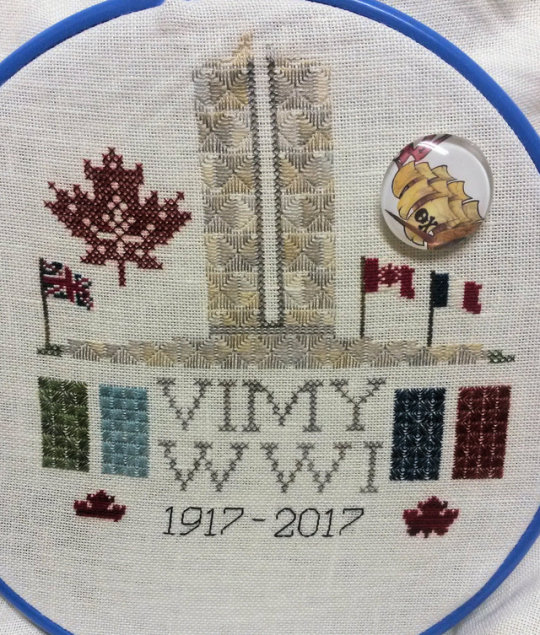



30 for 30 Update, didn’t actually get much done yesterday as I was playing with my nails instead. Also, today is going to be my skip day, no stitching for me as I’m going to a show tonight
13 notes
·
View notes
Text
As number of Second World War veterans dwindles, Legion faces bigger challenge on Remembrance Day
It's now 75 years since the end of the Second World War and with each passing year, we are losing more and more of those who remember the horrors of war first-hand.
An oak tree just across the street from Fredericton's cenotaph was planted by a Second World War veteran in memory of the Battle of Vimy Ridge.
That veteran has since passed away, and Fredericton Legion President Don Swain says we must never forget the fallen.
"It's something that should be done every year," Swain said. "Even COVID-19 wasn't going to keep the legion from doing this."
Veterans Affairs Canada estimates that of the one million men and women who went overseas, only 26,200 remain.
As of March of this year in the Maritimes, Veterans Affairs says there are:
200 on Prince Edward Island;
1,200 in Nova Scotia; and,
800 in New Brunswick.
Those estimates mean that we've lost about 500 Second World War veterans in the Maritimes this past year. Their average age is in the mid-90s.
This year's ceremony in Fredericton saw a much smaller crowd because of COVID-19 restrictions.
But several Second World War veterans did attend, viewing the ceremony from inside a bus.
"They all must be as old as I am," said 95-year-old Helen Dorcas, who was awarded a Memorial Silver Cross.
She lost her husband in the war and he's now buried in Germany.
"There's a few of them left, but not too many," Dorcas said.
Someday, Canadians will have to learn to remember the Second World War on their own, without the people who lived it.
But some work to ensure stories from the great wars live on, like Mike Legere - who shares the story of the Forestry Corps.
"Especially in the First World War, they provided a lot of the timber that was required for operations, military operations, and a lot of those people in the corps came from Canada," said Legere of Forest NB. "We had the expertise, we knew how to grow trees, we knew how to manage forests. and we knew how to harvest and get timber to where it needed to be."
from CTV News - Atlantic https://ift.tt/3eQjuTO
1 note
·
View note
Text


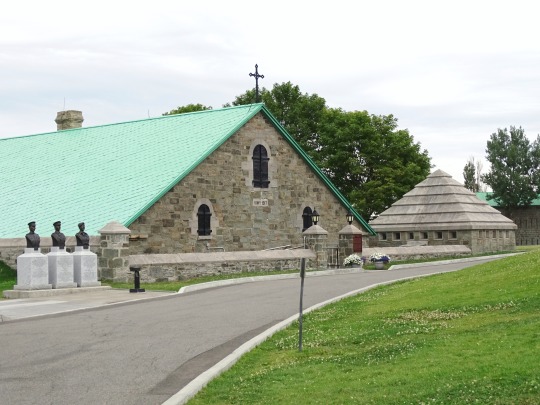
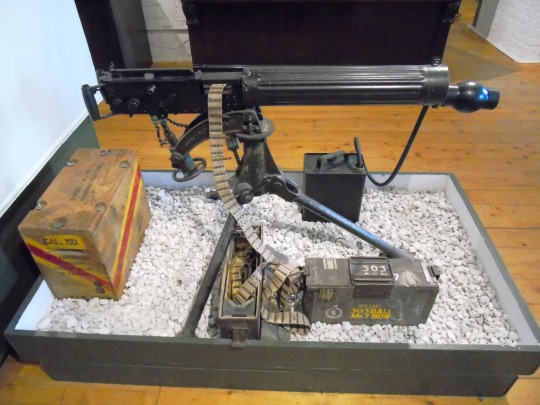
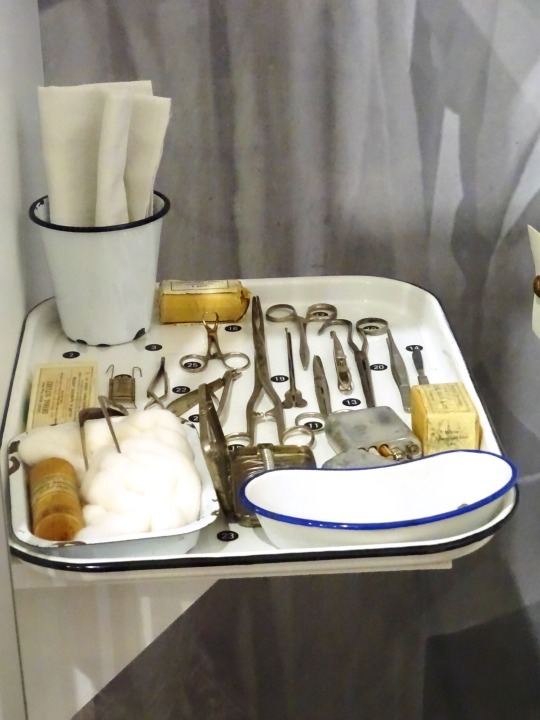


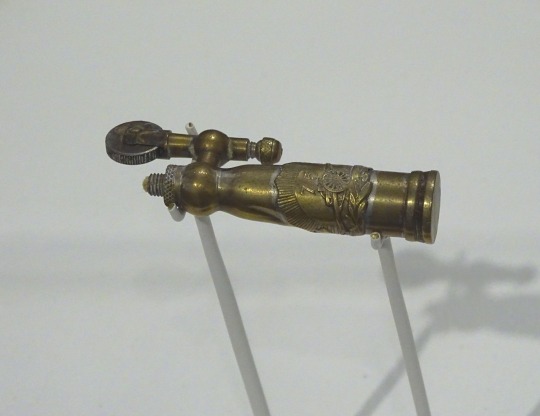
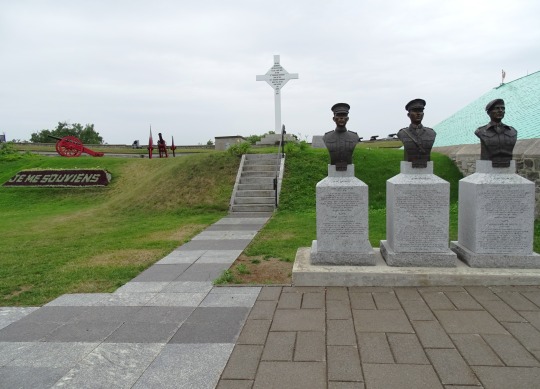


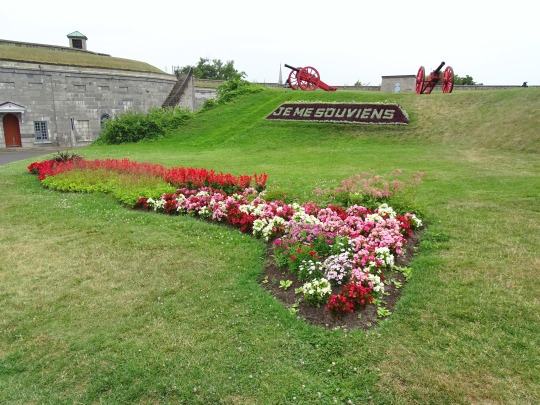
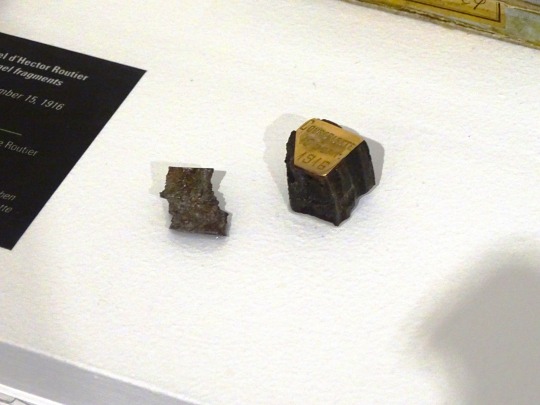
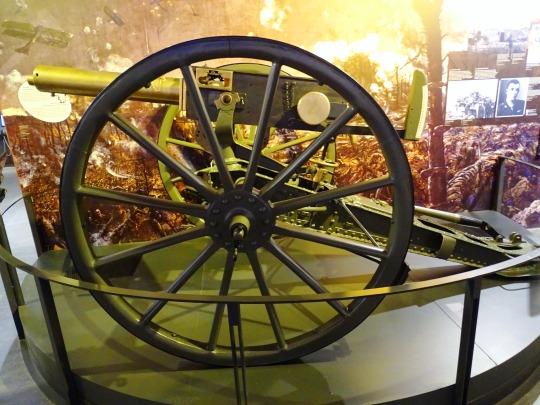
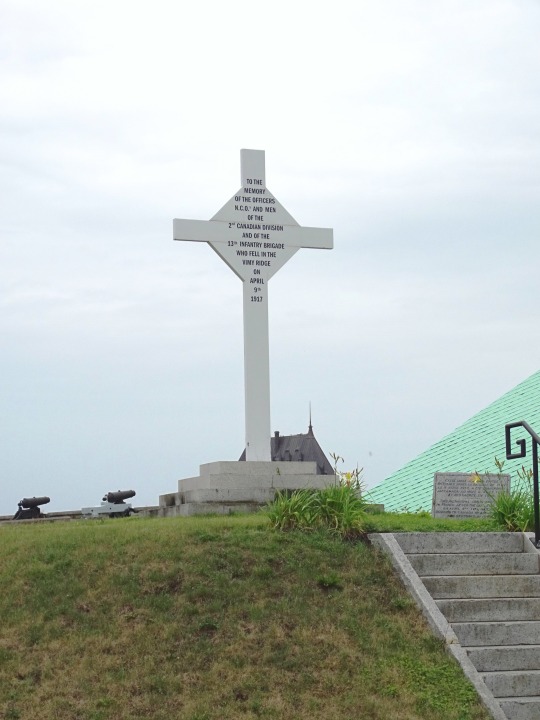
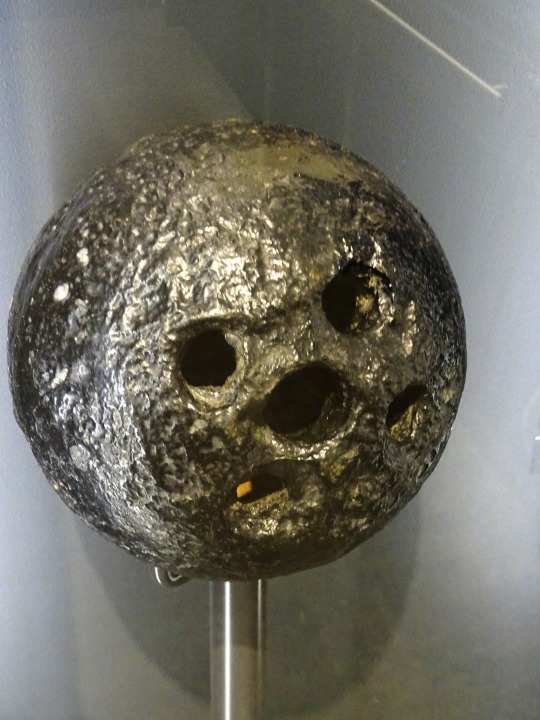

The Battle of Arras began with Canadian Corps executing a massive assault on Vimy Ridge on April, 9, 1917.
Vimy Ridge Day
Since 2003, Vimy Ridge Day has been observed on April 9 in Canada to honor and commemorate the Battle of Vimy Ridge, which took place during the First World War at Vimy Ridge, France, in 1917. The Canadian flag on Parliament Hill’s Peace Tower in Ottawa is required to be lowered to half-mast by law. Wreath-laying ceremonies are held at the Canadian National War Memorial in Ottawa, the Canadian National Vimy Memorial in France, and other locations around the country.
History of Vimy Ridge Day
The Victory of Vimy Ridge Battle was considered a historic moment in the country’s history. The victory was not easy to attain, as years of failed attempts, strategic planning, and preparation to regain Vimy Ridge were endured. The Ridge was under Germany’s control since 1914. Since then, around 150,000 British and French soldiers were sacrificed in the attempt to retake the ridge. The Germans secured their position with machine gun fires, barbed wires, and deep bunkers, making it difficult for any country to take over. Because of their remarkable achievements, Canadian troops gained a reputation as formidable and effective troops. However, the victory came at a horrific price, with over 10,000 people either murdered or wounded.
In April 1917, the Canadian Corps was given the order to seize Vimy Ridge. The heavily constructed seven-kilometer ridge in northern France provided a superb view of the Allied lines. Because earlier French attacks had failed with over 100,000 dead, the Canadians would be attacking over an open graveyard. Canadian and British artillery blasted German positions on the ridge before a week to the battle, killing and torturing defenders. With almost 1,000 artillery pieces putting down withering, supporting fire, the Canadian soldiers would be strongly backed when they went into the fight.
The four divisions of the Canadian Corps fought bravely together for the first time during the Vimy Ridge Battle. Around 15,000 soldiers initiated the battle at 5:30 a.m. on April 9, 1917, marching under a slow-moving bombardment of almost 1000 heavy guns. Most objectives were met on time, and by afternoon, most of the ridge had been taken, except for ‘The Pimple’, a high position on the ridge’s north end, where defenders held out until April 12. By the 12th of April, the Canadians had captured all of their objectives as well as 4,000 prisoners. Vimy Ridge was captured by the Canadians. During the four-day combat, 3,598 Canadians died and 7,000 were injured, making this victory a costly one.
Vimy Ridge Day timeline
1914 German Capture
The Germans gain control of Vimy Ridge at the beginning of World War I.
1917 The First Attack
The Battle of Vimy Ridge begins in the early morning at 5:30 a.m on April 9.
1917 The End of the Battle
The Battle of Vimy Ridge comes to an end on April 12 with a victory for the Canadian Corps.
1918 Canada’s Last Battle in World War I
The Canadian Corps defeats the last German defensive lines with the Vimy tactics on November 1.
Vimy Ridge Day FAQs
What did the Battle of Vimy Ridge reveal?
The triumph of the Canadians at Vimy Ridge revealed that no position was unconquerable to a well-planned and executed attack. This victory had a significant impact on allied planning.
How many lives were lost at Vimy Ridge?
The enormous victory came at a high cost of 3,598 Canadian lives and approximately 7,000 wounded Canadian soldiers.
Does Canada own Vimy Ridge?
Even though the ridge is located in France, it has belonged to Canada as a Canadian National historic site since 1997.
How to Observe Vimy Ridge Day
Wear a Vimy pin
Share your story
Lay wreaths
Canadian people commemorate this day by wearing Vimy pins. The Vimy pin should be worn on the left-hand side of the lapel buttonhole position.
On this commemoration day, we could share our knowledge and stories we heard about the battle and stories with others. Take this opportunity and spread your knowledge about the battle!
The Late Soldiers can be honored by wreath-laying ceremonies. Community members, Veterans, and the public lay wreaths at the National War Memorial to pay their respects.
5 Amazing Facts About The Battle Of Vimy Ridge
Land for memorial
Dream memorial
The great endeavor
A historic site
Standing tall on the hill
The French government awarded the people of Canada perpetual use of the land for the battlefield park that houses the Canadian National Vimy Memorial in 1922.
Walter Seymour Allward, a Canadian artist and architect, constructed the Vimy memorial — he once told a group of friends that the design's form came to him in a dream.
On July 26, 1936, it was dedicated by King Edward VIII, in the presence of President Albert Lebrun of France and 50,000 or more Canadian and French soldiers and their families, after an eleven-year construction period costing $1.5 million.
Sheila Copps, then Minister of Canadian Heritage, recognized the Canadian National Vimy Memorial as a Canadian National Historic Site on April 10, 1997.
The National Vimy Memorial overlooks the 1917 battlefield in Canada and is located on Hill 145.
Why Vimy Ridge Day is Important
It honors bravery
The winning tactics
It celebrates unity
Although many lives were lost in the battle, it still stands as an important historic moment in the history of Canadian Bravery. It is celebrated as a remembrance of the bravery of the soldiers.
The Canadian Corps went through a lot of training before the battle. The tactics framed by the corps were so clever that they helped win other battles also.
All four Canadian corps fought together in this battle as an alias of the British to regain Vimy Ridge. This celebrates unity!
Source
#Royal 22e Régiment Museum#Vimy Ridge Cross#Citadelle of Quebec#travel#Quebec City#Québec#The Road to Vimy and Beyond#Fort George#Halifax#Halifax Citadel National Historic Site of Canada#Nova Scotia#summer 2018#2015#WWI#World War One#Army Museum Halifax Citadel#Battle of Arras#started#9 April 1917#anniversary#Canadian history#World War I#WWOne#Vimy Ridge Day#original photography#vacation#tourist attraction#cityscape#architecture#landmark
1 note
·
View note
Text
Events 4.12 (before 1960)
240 – Shapur I becomes co-emperor of the Sasanian Empire with his father Ardashir I.
467 – Anthemius is elevated to Emperor of the Western Roman Empire.
627 – King Edwin of Northumbria is converted to Christianity by Paulinus, bishop of York.
1012 – Duke Oldřich of Bohemia deposes and blinds his brother Jaromír, who flees to Poland.
1204 – The Crusaders of the Fourth Crusade breach the walls of Constantinople and enter the city, which they completely occupy the following day.
1606 – The Union Flag is adopted as the flag of English and Scottish ships.
1776 – American Revolution: With the Halifax Resolves, the North Carolina Provincial Congress authorizes its Congressional delegation to vote for independence from Britain.
1807 – The Froberg mutiny on Malta ends when the remaining mutineers blow up the magazine of Fort Ricasoli.
1820 – Alexander Ypsilantis is declared leader of Filiki Eteria, a secret organization to overthrow Ottoman rule over Greece.
1831 – Soldiers marching on the Broughton Suspension Bridge in Manchester, England, cause it to collapse.
1861 – American Civil War: Battle of Fort Sumter. The war begins with Confederate forces firing on Fort Sumter, in the harbor of Charleston, South Carolina.
1862 – American Civil War: The Andrews Raid (the Great Locomotive Chase) occurs, starting from Big Shanty, Georgia (now Kennesaw).
1864 – American Civil War: The Battle of Fort Pillow: Confederate forces kill most of the African American soldiers that surrendered at Fort Pillow, Tennessee.
1865 – American Civil War: Mobile, Alabama, falls to the Union Army.
1877 – The United Kingdom annexes the Transvaal.
1900 – One day after its enactment by the Congress, President William McKinley signs the Foraker Act into law, giving Puerto Rico limited self-rule.
1910 – SMS Zrínyi, one of the last pre-dreadnought battleships built by the Austro-Hungarian Navy, is launched.
1917 – World War I: Canadian forces successfully complete the taking of Vimy Ridge from the Germans.
1927 – Shanghai massacre of 1927: Chiang Kai-shek orders the Chinese Communist Party members executed in Shanghai, ending the First United Front.
1927 – Rocksprings, Texas is hit by an F5 tornado that destroys 235 of the 247 buildings in the town, kills 72 townspeople and injures 205; third deadliest tornado in Texas history.
1928 – The Bremen, a German Junkers W 33 type aircraft, takes off for the first successful transatlantic aeroplane flight from east to west.
1934 – The strongest surface wind gust in the world at the time of 231 mph, is measured on the summit of Mount Washington, New Hampshire. It has since been surpassed.
1934 – The U.S. Auto-Lite strike begins, culminating in a five-day melee between Ohio National Guard troops and 6,000 strikers and picketers.
1937 – Sir Frank Whittle ground-tests the first jet engine designed to power an aircraft, at Rugby, England.
1945 – U.S. President Franklin D. Roosevelt dies in office; Vice President Harry S. Truman becomes President upon Roosevelt's death.
1945 – World War II: The U.S. Ninth Army under General William H. Simpson crosses the Elbe River astride Magdeburg, and reaches Tangermünde—only 50 miles from Berlin.
1955 – The polio vaccine, developed by Dr. Jonas Salk, is declared safe and effective.
0 notes
Text

The Great War
One hundred years ago at the 11th hour of the 11th day of the 11th month the armistice agreement was signed between the Allied Forces and Germany bringing peace to the Western Front and ending the war.
Unsurprisingly, given its importance to many of the story lines and characters in the show, there are many fabulous fics that mention the War to end all Wars. For this post I’ve traced the journey of the 14th Battalion (Melbourne), 4th Brigade, New Zealand and Australian Division/Australian 4th Division of the Australian Imperial Force and chosen stories that mention some of the Battles the 14th were involved in.

The 14th Battalion of 1,023 men was raised in Melbourne in September 1914. They left Australia in December and reached Egypt in January 1915. In Australia 39% of men between the ages of 18 and 44 fought in World War One, all of them were volunteers.
Chapter Four of @rositalg's War Stories, Waking (2016-2018) – Concerned when he doesn’t come home for dinner Phryne goes looking for her Inspector and finds a gathering of the 14th Battalion at his house.
The Gallipoli Campaign, Turkey (19 February 1915 - 9 January 1916)
This was the 14th’s first engagement. As part of the 1st Division ANZACs, on the 25th April 1915 they took part in the ANZAC Cove Landing. They also fought in the Second Battle of Krithia, Chunuk Bair, Hill 971 and Hill 60. Lance Corporal Albert Jacka of the 14th was the first Australian to earn a Victoria Cross after holding a trench single handedly during a Turkish counterattack.
Chapter One of Universal Truths (2018) by @ollyjayonline – The 6th Battalion (Victoria) is under the command of a world weary British Major who, along with his loyal Captain, is doing his best to keep as many of his men alive as he can. Fifteen years later Jack remembers a long forgotten warning.
Jack’s War (2018) by akraia – Jack is in the 23rd Battalion (Melbourne) who joined the Gallipoli campaign in mid-August. With the 24th Battalion (Victoria) they took over the defence of Lone Pine from the 1st Division in September 1915 and were subjected to constant shelling. Almost half of the Australians involved in the taking and defence of Lone Pine were casualties. The Australian Dawn Service is held at Lone Pine on the 25th April every year.
The number of wounded on medical ships, the surrounding Greek islands and the Australian hospitals in Cairo far outweighed the medical supplies and accommodation that were available. 2,800 Australian nurses served during the war, initially at Cairo then after the evacuation they were re-posted to No.17 British Military Hospital in Alexandria.
Chapter Two of War Stories, Sisters in the Park (2016-2018) by @rositalg – Jack and Phryne come to the aid of a woman who served in Alexandria.
The 14th was shipped back to Egypt in December 1915 and reorganised to combine veterans with the men fresh from Australia before becoming part of the 4th Division. As part of II ANZAC they were assigned to the defence of the Suez Canal from Turkish invasion. Then the French losses at the Battle of Verdun, France (21 February - 18 December 1916) made it clear that more men were required on the Western Front.
The Battle of the Somme, France (1 July - 18 November 1916).
In June 1916 the 14th was reassigned to I ANZAC and sent to Armentières where they raided German trenches.
Stand-To for the 5,533 (2016) by LauramourFromOz – Fromelles (19 - 20 July) was the first battle of the AIF on the Western Front and was fought by the 5th Division. It included the 14th and 15th Brigades from Victoria. This fic starts with Jack being shot as he tries to keep a promise to a friend. In 1929 he is reunited with the Australian nurse who risked her own life to save him and helped him to fulfill his promise.
At Pozières (23 July - 3 September) the 14th relieved the severely depleted 2nd Division just in time for a German counterattack. In disarray the Australians were overrun and it looked like Pozières was lost when, the now Second Lieutenant Jacka led a desperate charge of seven men on a large group of Germans that had rounded up forty Australians. This inspired the prisoners to rise up and engage in hand-to-hand combat. They repelled the attack which was the last attempt of the Germans to take the village. Jacka, wounded seven times, received the Military Cross. I ANZAC was then assigned defensive duties over the bitter winter, with the arrival of spring though they began a series of patrols along the front line.
The Battle of Arras, France (9 April – 16 May 1917)
On the 8th April Captain Jacka, now the 14th’s Intelligence Officer, led a night party on reconnaissance to the German line obtaining valuable information and putting in place guides for the assault parties. The 14th attrmpted to take the village of Bullecourt (10 - 11 April). There weren't enough tanks to destroy the barbed wire and miscommunication meant they had limited artillery support so, though they briefly held some German positions, eventually they were forced to retreat.
Nocturne (2015) by @gaslightgallows – Jack tells Phryne about meeting a soldier injured at Vimy Ridge (9 –12 April) whilst he was recovering in a convalescent home and how a shared love of music kept them both sane.
Third Battle of Ypres/Passchendaele, Belgium (31 July - 10 November 1917)
The 4th Division was at Menin Road (20 September), Polygon Wood (26 September), Broodseinde (4 October) and then the rain turned the battle-scarred fields into mud in which men and horses drowned. To make things worse mustard gas was used for the first time. There were 1,250 Australian casualties at Poelcapelle (9 October), followed by complete disaster when the ANZACs attempted to capture Passchendaele (12 October) suffering 7,000 casualties.
Entrenched (2018) by Scratch_Pad – Beautifully interweaves Jack’s experiences throughout the episodes with his memories of the war.
A Love Story (2018) by @ollyjayonline – Jack is on his way to England and Phryne, when he diverts to Ypres to lay to rest old ghosts. There he is reminded that life truly is for the living.
In November 1917 the five Australian infantry divisions became the Australian Corps and from then to October 1918 the 14th was engaged in almost constant action.
Battle of Cambrai, France (20 November - 8 December 1917)
America joined the war in April 1917 but their first engagement with the enemy was 30 November when the 11th Engineer (Railway) Regiment were attacked whilst they were digging reserve trenches.
Silk, Smoke, Sky (2018) by QualiTea - Phryne coaxes a damaged ambulance past shell holes and smoking metal to get wounded soldiers to the hospital.
Coded Expressions (2016) by @omgimsarahtoo – Jack is contacted by an old war buddy and finds himself in the outback looking for answers to something that happened in February 1918 on the outskirts of Cambrai.
The Spring Offensive, France and Belgium (21 March – 18 July 1918)
The 14th fought in Operation Michael, France (21 March - 5 April) at the village of Amiens, France.
Learning By Heart the Ways of the World (2016) by longwhitecoats – In the build up to the First Battle of Villiers-Bretonneu France (30 March - 5 April) Phryne finds herself on a mercy mission in an ambulance, fortunately she is not alone.
The Hundred Days Offensive (8 August to 11 November 1918)
The 14th were again at Amiens (8 - 12 August). The attack began at 4am in dense fog and by 8.20am the 4th Division had breached the German lines.
In October 1918, along with all the other Australian troops, the Battalion was withdrawn from the front line and demobbed in November. Over the course of the war the 14th had suffered 915 deaths and 2,229 casualties.
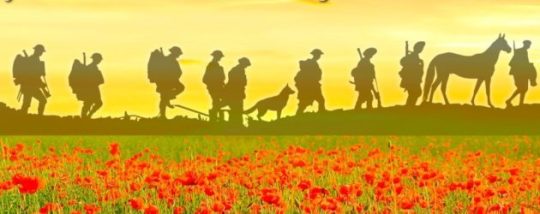
At the going down of the sun, and in the morning,
We will remember them.

#11.11: lest we forget#the great war#lest we forget#mfmm fanfic#miss fisher's murder mysteries#the wardlow collection
49 notes
·
View notes
Photo

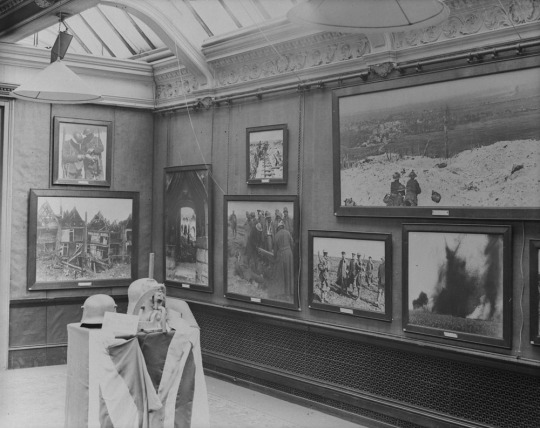

2nd Exhibition of Canadian Battle Pictures in July of 1917
M-262S, M-262P, M-262B

On display was “the largest photograph in the world,” 11 x 20 feet, on 5 panels, renamed: “the Taking of Vimy Ridge.”
Item no. (creator):M-262
Item ID number:3394842
Ivor Castle’s The Taking of Vimy Ridge.
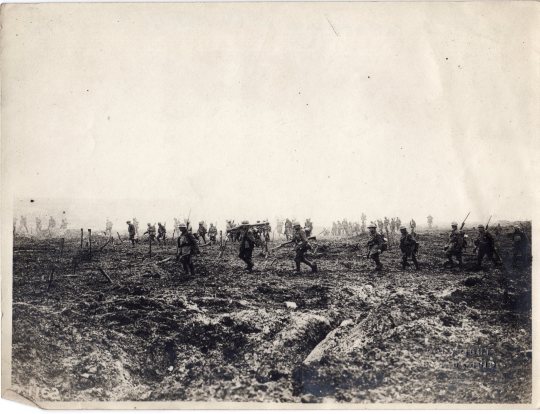
accession # 2018.413.1162. The original title of the photograph is “29th Infantry Battalion Advancing Over No Man’s Land Through German Barbed Wire and Heavy Fire During the Battle of Vimy Ridge.”
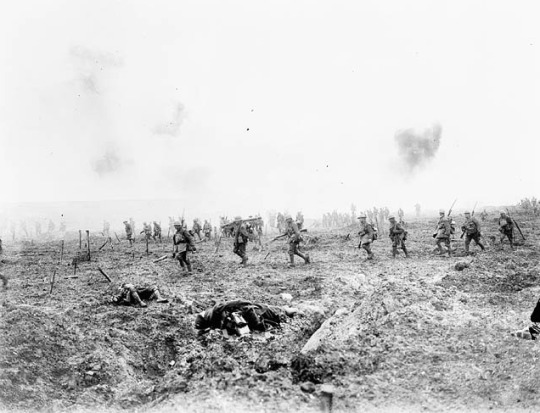
Shell bursts have been added in the background and bodies in the foreground (bodies from O-1188 )


Item no. (creator):M-262M
Item ID number:3394835

Item no. (creator):O-1474
Item ID number:3396712
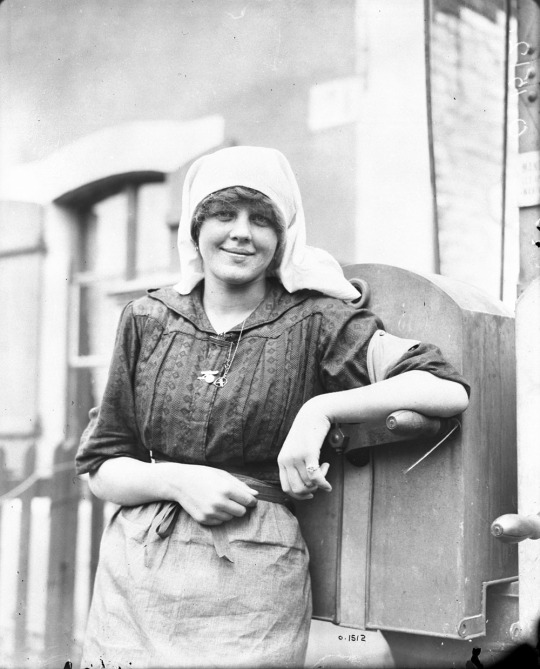
Yvonne, the railway crossing gate keeper just behind the Canadian lines. June, 1917
Item no. (creator):O-1512
Item ID number:3397376
At the July 1917 2nd Exhibition of Canadian Battle Pictures there is a shot, M-262A, of mules moving to the front. On right is Apr 1917 William Ivor Castle photo of packhorses transporting ammunition to the 20th Battery, Canadian Field Artillery: O-1242, O-1243


Colourized by Royston Colour

At the July 1917 2nd Exhibition of Canadian Battle Pictures there is a shot, M-262L. On the left, there is a May 1917 William Ivor Castle photo of Canadians leaving on trucks after the Battle of Vimy Ridge probably cropped O-1406. The Colourized image here is O-1405

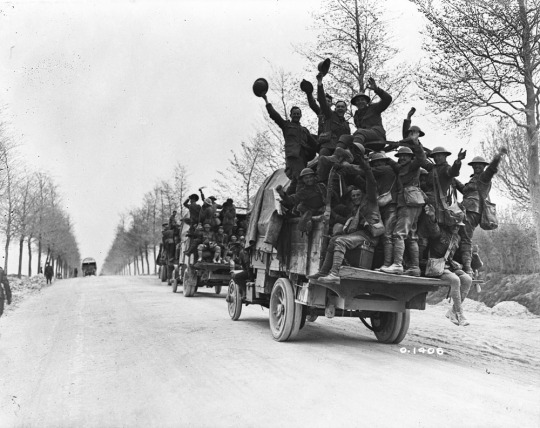

At the July 1917 2nd Exhibition of Canadian Battle Pictures there is a shot of pictures displayed, M-262K. On the right, there is a possible Mar 20 1917 Ernest Brooks shot of a church in Mons-en-Chausee IWM Q 1902 (Colourised by Frédéric Duriez) or cropped IWM Q 1913
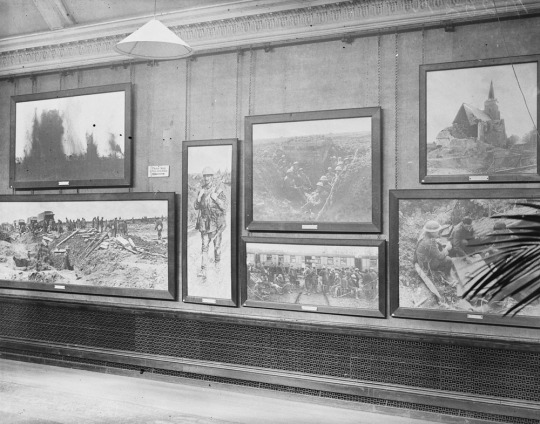


At the July 1917 2nd Exhibition of Canadian Battle Pictures, there is a shot of pictures displayed, M-262E. In the center, there is a photo, O-1574, captioned "The gun of a Tank - hit but not out of action. July, 1917"


At the July 1917 2nd Exhibition of Canadian Battle Pictures, there is a shot of pictures displayed, M-262N. In the center, there is a photo, O-1568, captioned "Tanks waiting to go into action. July, 1917"
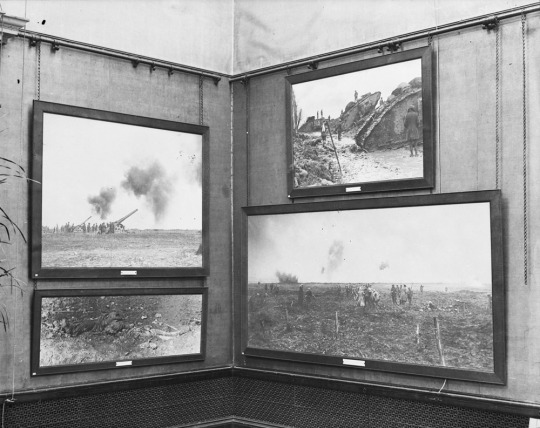
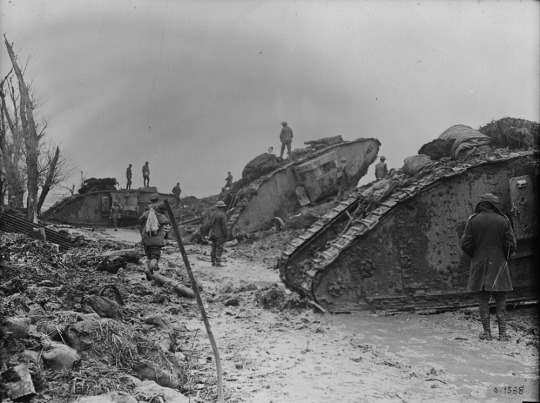
At the July 1917 2nd Exhibition of Canadian Battle Pictures, there is a shot of pictures displayed, M-262D. In the center, there is a horizontally flipped photo, O-1569, captioned "Tanks waiting to go into action. July, 1917"


At the July 1917 2nd Exhibition of Canadian Battle Pictures, there is a shot of pictures displayed, M-262R. In the center, there is a photo, O-1296, of a soldier in a Howitzer barrel captioned "The breach of a big Howitzer. May, 1917." Taken from the same time is O-1297



22 notes
·
View notes
Text
The Art of War and the Killing Joke - The Comedy Company

(The PPCLI Comedy Company circa 1917-1919 - photo, public domain)
From 1914-1918, more than 600,000 Canadians packed up their troubles and merrily marched, flags waving, into the trenches and foxholes of Flanders and France. By the time the Armistice was signed at 11:00 am on November 11, 1918, more than 59,000 were dead, over 172,000 wounded. Globally, more than 10 million soldiers died, resulting in a “lost generation.” White crosses row on row, cenotaphs, literature, and visual art are some of The Great War’s tangible legacies. The lingering wounds of bereaved families and communities as well as the true extent of the conflict’s effects on the nation’s psyche are sepia-toned intangibles.
The development of Canadian sketch comedy is one of the Great War’s unexpected legacies. When playwright and history buff Neil Grahn was sorting through the archives of a Canadian regiment – Princess Patricia’s Canadian Light Infantry (PPCLI) – for another project, he discovered the fascinating story of the PPCLI Comedy Company. The tiny band of soldiers entertained their comrades; they fought, Ross rifles in hand, in some of the war’s bloodiest theatres.
Their story is the subject of Grahn’s script, The Comedy Company Or: What’s So Funny about Death, Mud, and Machine Guns? A Fictional Recounting of an Absolutely True Story. It traces the company’s journey through the Ypres Salient, juxtaposing their original comedy sketches and songs with the grinding realities of war – its sounds, smells, textures, and shell shock.

(Battle scene, The Comedy Company - photo Marc J. Chalifoux)
“Our involvement in World War One was immersive,” says Grahn “It nearly drowned us.”
The real Comedy Company was the brainchild of Major, later Lieutenant Colonel, Agar Adamson. His rationale was simple and a bit chilling. Lift the troops’ morale through humour, let them escape the horrors, inspire them to fight through the meat grinder of trench warfare.
LILLEY: Okay, I’m looking at it like this. If we can come up with a show that makes the rest of our boys forget, even for minute, what a stinking, butcher’s shop we’re all stuck in - then maybe we’ll be doing some good.
FENWICK: Yeah, I guess if we can get the boys to relax and have a laugh, they might be a little sharper next time they’re in the front trenches.
CUNNINGHAM: Exactly. It’s a simple formula. We boost morale - make troops more happy. Troops feel better - they kill more Germans.
MCLAREN: Yes! And when we kill enough Fritzies, they give up, the war ends, and we get to go home! Our little show’s ultimate mission is to help our boys with their killing. We’re going to create comedy for killing!
CUNNINGHAM: You know what McLaren? That’s the first thing you’ve said today I’ve liked. ‘Comedy for killing’ – Let’s hear it on three boys! One, two three…
ALL: Comedy for killing!
(The Comedy Company, Act I, Scene 7)

(Sheldon Elter and Andrew MacDonald Smith - photo Marc J. Chalifoux)
“This company was absolutely used as a tool by high command,” says Grahn, “but its execution brought the men together. Yes, it was designed for esprit de corps, but it was good on a human scale because it allowed an escape for the men. What fascinated me, what forms the heart of the show is the story of humans finding morale and sanity in a situation that dwarfs anything anyone’s experienced in terms of horror and discomfort. That attitude of ‘I hate the bastards that started this thing. I joke so that I may live’.”
Moreover, the troupe laid the foundation of a uniquely Canadian brand of sketch comedy.
“These guys were the granddaddies of sketch as we know it in Canada,” Grahn says. “I’m part of that legacy through things like The Irrelevant Show and Three Dead Trolls in a Baggie. They looked at life around them and made fun of that; the rifles, webbing, bully beef, and mud in boots. It was authentic, Canadian, not the usual British thing of singing Gilbert and Sullivan. The form came back to Canada – which at the time was trapped in the pincers of America and Britain. It is part of our national character. Wow.”
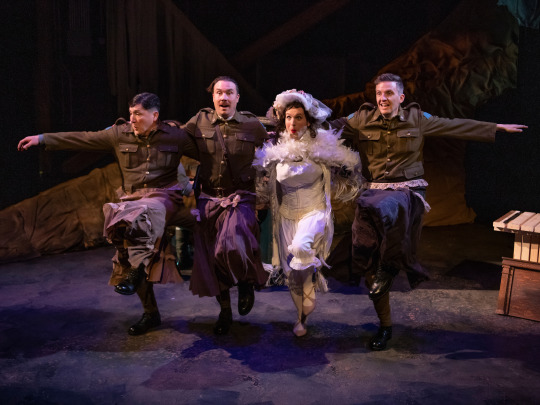
(Sheldon Elter, Jesse Gervais, Steven Greenfield, and Andrew MacDonald Smith dance a cancan in The Comedy Company - photo Marc J. Chalifoux)
The play joins a canon of scripts by Alberta playwrights that take on different aspects of the Canadian experience of WW1 – Vern Thiessen’s Vimy and Stephen Massicotte’s Mary’s Wedding. Although The Comedy Company examines a different aspect of the conflict, it too is an act of remembrance.
“One hundred years isn’t really such a long time ago,” says Shadow Theatre artistic director John Hudson, who also directs the show. “My Great Uncle was one of the many underage soldiers who enlisted under a false name. He never came home. I choke up when I think of him and how it destroyed the family. They were wrecked, and my story is just one of millions. Go to Newfoundland and on July 1, they remember the Newfoundland Regiment, which was slaughtered on July 1, 1916 at Beau Hamel.”
Both Hudson and Grahn agree that the men of The Comedy Company were “comedian warriors” who helped their comrades through the worst, and probably allowed many to survive in the face of despair.
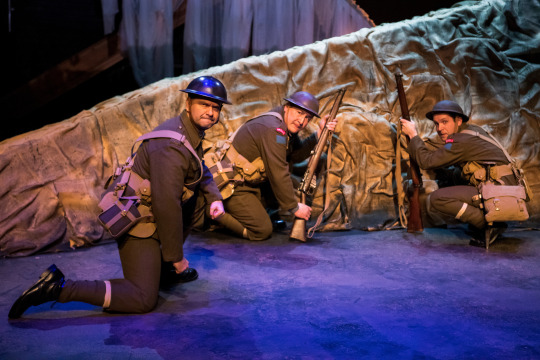
(Nathan Cuckow, Sheldon Elter, and Steven Greenfield hunker down in a trench - image Marc J. Chalifoux)
Several of the men were wounded, and the first commanding officer, Lieutenant Cunningham, was so badly injured in the attack on Vimy Ridge he never returned to active duty. Lieutenant Colonel Adamson was seriously wounded at Passchendaele – but The Comedy Company marched on into memory and applause. The conclusion of their story is beautifully summed up by Edmonton’s Colin Maclean in his Gig City review:
“Later, the comedy troupe joined with another collection of players to form the famous “Dumbells.” They performed before the King and even had a run on Broadway.
But, mostly, they continued to entertain the troops.
More full disclosure: I grew up with stories about the “Dumbells” because one evening, in the audience, among hundreds of his fellows, was my own father. He never forgot that night.”
Shadow Theatre’s production of The Comedy Company runs at the Varscona Theatre until November 11. Tickets are available here.
There are many events in Edmonton commemorating Remembrance Day and the 100th anniversary of the Armistice. Here are a few
Armistice100 will take place at the Alberta Legislature on Sunday, November 11 beginning with a 21 Gun Salute at 11am
Project Heroes continues at the Prince of Wales Armouries Heritage Centre. This exhibit uses stories, individual portraits and larger paintings to honour the lives of Canadian soldiers who died in Afghanistan.
The Loyal Edmonton Regiment Museum will hold a Remembrance Day ceremony at the Prince of Wales Armouries Heritage Centre at 11am on Sunday, November 11.
Redpatch continues its run at the Citadel Theatre until November 11
WWI stats - https://www.warmuseum.ca/firstworldwar/history/after-the-war/legacy/the-cost-of-canadas-war/)
#shadowtheatre#yegarts#RemembranceDay#armistace100#princesspatriciascanadianlightinfantry#ppcli#neilgrahn#yegtheatre#edmonton#varsconatheatre
1 note
·
View note
Photo

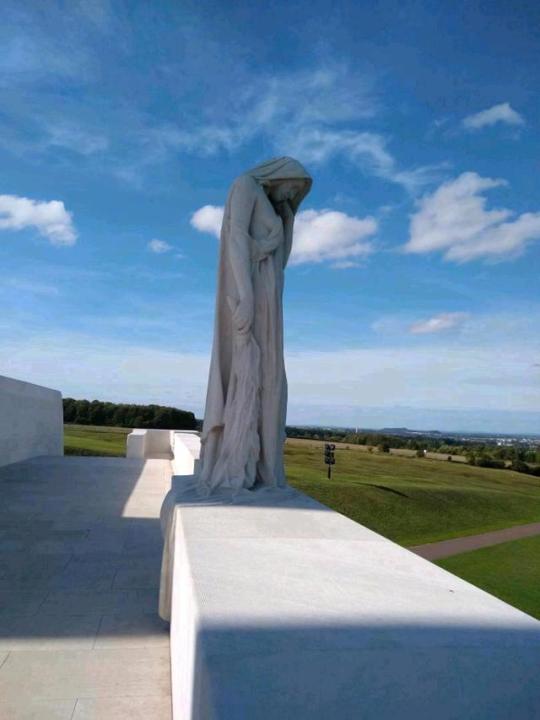

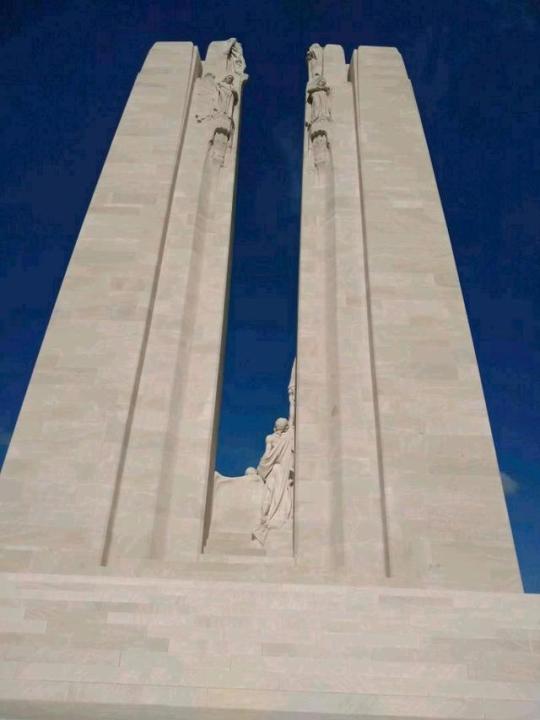
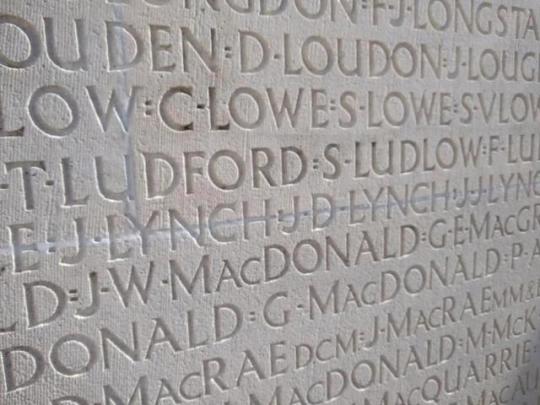



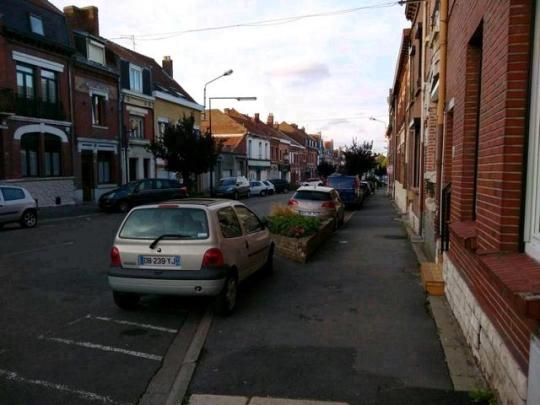

Overcast Clouds, 22°C
D55, 62580 Givenchy-en-Gohelle, France
Monday 10th September 2018
Today we were due to make the crossing to France and were booked on the Eurotunnel 1050hrs crossing. We had to check in at about 1000hrs and our hosts had advised that a 0900hrs departure would be more than adequate to make the deadline. After a hearty breakfast provided by said hosts we set off for the Folkestone terminal in fine weather and apart from having to follow an inconsiderate farmer and his oversize tractor for several miles at 30mph (AGGHH) we arrived at the terminal in good time at which time my phone rang. Caller display showed the caller to be my uncle Tom whom we had left only 45 minutes earlier , Well it wasn’t going to be good news was it ! Sure enough it transpired that Rhian had left her handbag containing her purse at their house and Tom was offering to bring it to us prior to our departure. After the initial shock horror we realised that there was nothing in the bag or purse that was essential and we decided to pick them up on our way home , whenever that would be. The check in procedure was without incident and we found ourselves in very expensive company in the queue with a Lamborghini Gallardo Spyder directly in front of us and in front of that was one of those new Rolls Royce SUV things. Very ugly. The Eurotunnel blurb states that the crossing takes 35 minutes which is correct when the train actually starts moving but by the time you add up check in and waiting time at either end it is nearer one hour 35 minutes. I took the opportunity to catch up on my journal entry for yesterday and also thought it might be prudent to give some thought as to were we were actually going today. I hastily browsed some of my guide books and decided that as we were ultimately travelling down toward the Alps then this route would naturally take us through some of the battlefield areas of world war one and I zeroed in on a place called Vimy. This small village being synonymous with a famous battle for Vimy Ridge where close to 3600 Canadian mostly conscripted soldiers died whilst “successfully” taking this strategic position in April of 1917. The site is now a joint French / Canadian national war memorial and boasts a magnificent monument bearing the names of the dead. The site more than lived up to expectations and it was very humbling to walk around the site which had been hugely cratered by the massive artillery assault. We spent a couple of hours at the memorial site before setting off to look for our first Aire overnighter experience. An “Aire” being an area set aside specifically for motorhomes who are usually allowed to remain for up to 48 hours and are often free or available for a minimal charge . One of my apps came up trumps with an aire at nearby Avion which was only ten minutes drive and on arrival had one of only five spaces still available , Hurrah.
After parking up and sorting ourselves out we went for a walk into town and through the adjacent park and on our return found that the five “official’‘places had been increased to ten by late arrivals squeezing into the generous gaps left by the early arrivers. We clearly have a lot to learn about this new lifestyle !
Powered by Journey Diary.
3 notes
·
View notes